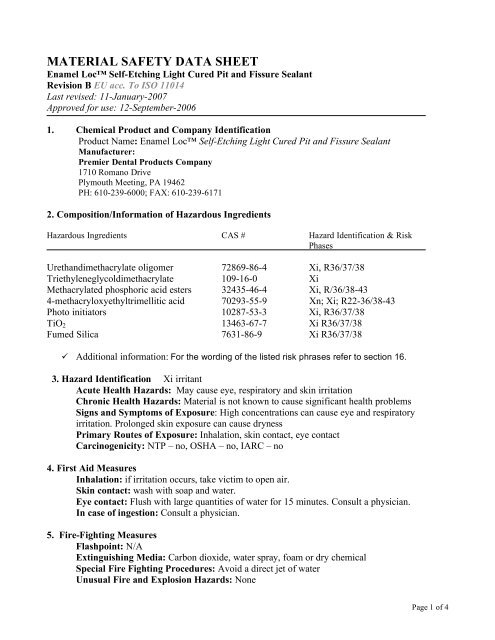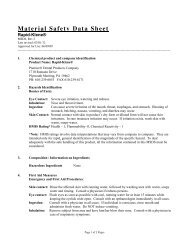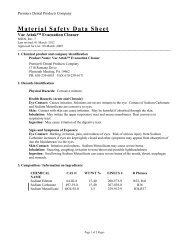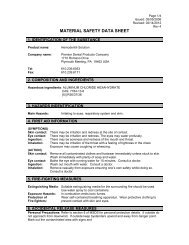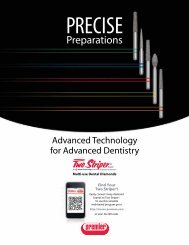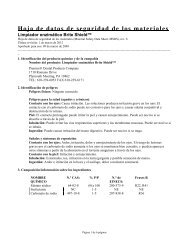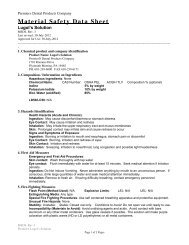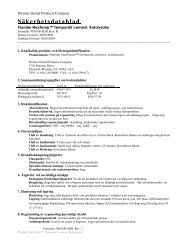Enamel Loc⢠English - Premier Dental
Enamel Loc⢠English - Premier Dental
Enamel Loc⢠English - Premier Dental
Create successful ePaper yourself
Turn your PDF publications into a flip-book with our unique Google optimized e-Paper software.
MATERIAL SAFETY DATA SHEET<br />
<strong>Enamel</strong> Loc Self-Etching Light Cured Pit and Fissure Sealant<br />
Revision B EU acc. To ISO 11014<br />
Last revised: 11-January-2007<br />
Approved for use: 12-September-2006<br />
1. Chemical Product and Company Identification<br />
Product Name: <strong>Enamel</strong> Loc Self-Etching Light Cured Pit and Fissure Sealant<br />
Manufacturer:<br />
<strong>Premier</strong> <strong>Dental</strong> Products Company<br />
1710 Romano Drive<br />
Plymouth Meeting, PA 19462<br />
PH: 610-239-6000; FAX: 610-239-6171<br />
2. Composition/Information of Hazardous Ingredients<br />
Hazardous Ingredients CAS # Hazard Identification & Risk<br />
Phases<br />
Urethandimethacrylate oligomer 72869-86-4 Xi, R36/37/38<br />
Triethyleneglycoldimethacrylate 109-16-0 Xi<br />
Methacrylated phosphoric acid esters 32435-46-4 Xi, R/36/38-43<br />
4-methacryloxyethyltrimellitic acid 70293-55-9 Xn; Xi; R22-36/38-43<br />
Photo initiators 10287-53-3 Xi, R36/37/38<br />
TiO 2 13463-67-7 Xi R36/37/38<br />
Fumed Silica 7631-86-9 Xi R36/37/38<br />
Additional information: For the wording of the listed risk phrases refer to section 16.<br />
3. Hazard Identification Xi irritant<br />
Acute Health Hazards: May cause eye, respiratory and skin irritation<br />
Chronic Health Hazards: Material is not known to cause significant health problems<br />
Signs and Symptoms of Exposure: High concentrations can cause eye and respiratory<br />
irritation. Prolonged skin exposure can cause dryness<br />
Primary Routes of Exposure: Inhalation, skin contact, eye contact<br />
Carcinogenicity: NTP – no, OSHA – no, IARC – no<br />
4. First Aid Measures<br />
Inhalation: if irritation occurs, take victim to open air.<br />
Skin contact: wash with soap and water.<br />
Eye contact: Flush with large quantities of water for 15 minutes. Consult a physician.<br />
In case of ingestion: Consult a physician.<br />
5. Fire-Fighting Measures<br />
Flashpoint: N/A<br />
Extinguishing Media: Carbon dioxide, water spray, foam or dry chemical<br />
Special Fire Fighting Procedures: Avoid a direct jet of water<br />
Unusual Fire and Explosion Hazards: None<br />
Page 1 of 4
6. Accidental Release Measures<br />
Environmental Precautions: Avoid seepage into sewers and water supplies.<br />
Clean-Up Procedure: Contain spill and pick up material with a suitable<br />
absorbent material. Place absorbent into a container for later disposal. Clean<br />
spill area with detergent and water.<br />
7. Handling and Storage<br />
Handling: No special measures necessary if handled according to instructions.<br />
Storage: Keep container tightly closed when not in use. Store in a cool, dry<br />
location. Keep material in original packaging.<br />
8. Exposure Controls/ Personal Protection<br />
Exposure Controls: Use only in well ventilated areas.<br />
Hand and Skin Protection: Avoid unnecessary skin contact. Wear latex gloves when<br />
handling.<br />
Hygiene Measures: Remove spilled material from skin and clothing. Do not<br />
eat or drink when handling this material.<br />
9. Physical and Chemical Properties<br />
Appearance: White paste<br />
Odor: Specific odor<br />
Boling Point/ Range: N/A<br />
Evaporation Bate (water = 1): N/A<br />
Vapor Density (Air = 1): N/A<br />
Solubility in Water: Insoluble<br />
10. Stability and Reactivity<br />
Stability: This material is stable.<br />
Hazardous Reactions: None if handled according to directions<br />
Hazardous Polymerization: May occur<br />
Conditions to Avoid: Heat; UV-light<br />
Incompatibility: Free radicals, reducing agents, heavy metal ions.<br />
Hazardous Decomposition Products: Carbon dioxide, carbon monoxide,<br />
acrylic decomposition products, depending on conditions of heating and<br />
burning.<br />
11. Toxicological Information<br />
Acute oral toxicity: LD50 (rat) > 5000 mg/kg<br />
Irritation of Skin: Dryness and irritation possible upon prolonged exposure.<br />
Allergic Effects: Methacrylate-sensitive individuals may exhibit an allergic<br />
reaction.<br />
12. Ecological Information<br />
Environmental persistence and degradability: No data available<br />
Ecotoxicity: No data available<br />
Do not discharge into sewers or water supplies.<br />
Page 2 of 4
13. Disposal Considerations<br />
May be disposed of in landfill or incinerator in accordance with local, state<br />
and federal regulations.<br />
14. Transport Information<br />
14.1 Transport at land ADR RID<br />
UN number<br />
Kemler Number<br />
Packing group<br />
Proper shipping name<br />
14.2 Transport at sea ADNR IMDG<br />
UN number<br />
MFAG<br />
EMS<br />
Packing Group<br />
Proper shipping name<br />
14.3 Air transport ICAO / IATA-DGR<br />
UN number<br />
Proper shipping name<br />
Subsidiary risk<br />
Labels<br />
Packing group<br />
U.S. DOT: Shipping Name: Not Regulated<br />
U.S. DOT: Hazard Class: None U.N/ N.A.<br />
Number: None<br />
U.S. Dot Packing Group: None<br />
Other: Not considered hazardous cargo<br />
15. Regulatory Information<br />
This product requires classification according to the criteria of EC.<br />
The product is a medical device according to the EC-directive 93/42.<br />
15.1 UN Number ---<br />
15.2 National regulations<br />
15.3 EU number<br />
15.4 Hazard symbols Xi<br />
15.5 Hazard designation Xi: Irritant. Contains 4-Methacryloxyethyltrimellitic acid.<br />
15.6 Risk phrases R: 22, 36, 37/38, 43<br />
22 Harmful if swallowed.<br />
36 Irritating to eyes.<br />
37/38 Irritating to respiratory system and skin.<br />
Page 3 of 4
43 May cause sensitization by skin contact.<br />
15.7 Safety phrases S: 2, 9, 16, 23, 26, 28, 24/25, 37/39<br />
2 Keep out of the reach of children.<br />
9 Keep container in a well-ventilated place.<br />
16 Keep away from sources of ignition - No smoking.<br />
23 Do not breathe vapor.<br />
26 In case of contact with eyes, rinse immediately with<br />
plenty of water and seek medical advise.<br />
28 After contact with skin, wash immediately with<br />
plenty of water and soap.<br />
24/25 Avoid contact with skin and eyes.<br />
37/39 Wear suitable gloves and eye/face protection.<br />
U.S. – O.S.H.A. Status: This material is not hazardous under the criteria of<br />
the U.S. Federal Hazard Communication Standard.<br />
16. Other Information<br />
These data are based on our present knowledge; however, they shall not constitute a guarantee<br />
for any specific product features and shall establish a legally valid contractual relationship.<br />
Relevant R-phrases<br />
22 Harmful if swallowed.<br />
36 Irritating to eyes.<br />
37/38 Irritating to respiratory system and skin.<br />
43 May cause sensitization by skin contact.<br />
Xn<br />
Harmful.<br />
Material should be maintained in original containers. Empty containers should not be re-used.<br />
AN SI / NFPA 704 DATA<br />
Fire = 1<br />
Health = 1<br />
Reactivity = 1 Specific<br />
This information is based on data considered accurate; however, no warranty is expressed or implied regarding the accuracy<br />
of these data, or the results to be obtained from use thereof. In no event will the manufacturer or distributor be responsible<br />
for damages of any nature whatsoever resulting from the use of, or reliance upon this information. General properties<br />
described herein are to be regarded as guides and are not guaranteed for all samples.<br />
010726 Rev2<br />
Page 4 of 4


